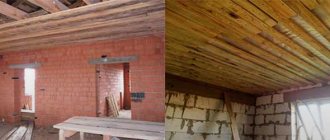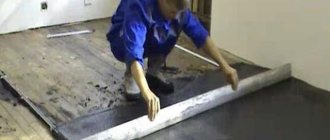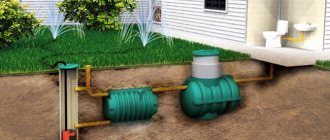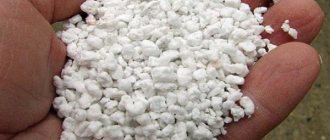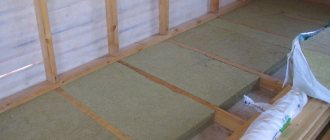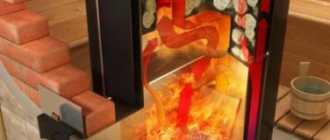Different materials are used to insulate the ceiling surface. In some cases, not only the thermal conductivity of the thermal insulation layer is important, but also its thickness. This is especially important when installing insulation on the residential side. Insulating the ceiling with foil insulation provides many advantages, but the main one is maintaining the height of the room. Let's consider the features, advantages and disadvantages of foil heat insulators, as well as the nuances of their installation on the ceiling surface.
Pros and cons of using Izolon insulation
Light-weight plastic insulation Izolon is produced by foaming polyethylene with small cells and closed pores. The structure of the final product allows it to be used for heat, water and noise insulation of various structures. Externally, the material is similar to foam rubber and may have aluminum foil. Supplied in rolls, blocks, sheets.
- Specifics of Izolon
- Technical indicators
- Material Dimensions
- Main varieties
- Izolon PPE
- Izolon NPE
- Foil
- Areas of operation
- Features of loggia insulation
- Creation of wall thermal insulation
- Thermal insulation of floor covering
- Installation features
Specifics of Izolon
Izolon based on fine-cell polyethylene foam has high thermal insulation properties and low weight. Some modifications are made with single- or double-sided lamination with aluminum foil. The thickness of the coating is 14 microns and provides waterproofness as well as reflective properties.
The material also has a reinforced frame in the form of a propylene mesh. The basis of Isolon is self-adhesive or glueless. There are combined varieties with foil and adhesive base on sale. To prevent the sheets from sticking together during transportation, a protective film is applied to the adhesive surface.
Types of foil insulation
Nowadays, there are several types of this material. They differ from each other not only in the density of the top layer, but also in the type of heat insulator.
The main types of foil-based insulation:
- Polyethylene foam (isolon, penofol, folgoizol) . This type is produced in rolls. The material is distinguished by its low price. Foamed polyethylene is used to create insulation. It can be either stitched or unstitched. The thickness of the canvas ranges from 3-10 mm. A distinctive feature is the presence of a self-adhesive surface. Some types of foil polyethylene foam have a reinforced layer, which is made from fiberglass mesh. As for the foil layer, it can be on one or both sides.
- Mineral wool . The material is distinguished by high levels of moisture resistance. Foil-coated mineral wool is sold not only in rolls, but also in the form of slabs. Basalt is often used for its production. Thanks to it, the service life of the canvas increases significantly. The material is used everywhere. This is due to good thermal conductivity and fire safety.
- Styrofoam . This foil insulation is intended for the “warm floor” system. Its density ranges from 30-50 kg/m. Available in the form of rolls 50 cm wide. The thickness of the canvas ranges from 3-5 mm.
Foil foam with markings
Important! Any type of material acts as an excellent sound insulator.
When used correctly, each type of foil insulation will perform its functions to the maximum. To get what you want, you just need to follow simple rules.
Penofol and isolon - their properties and characteristics
Foamed polyethylene serves as the base in these materials. The reflective foil coating can be on one or both sides.
The following types of these thermal insulation materials can be found on sale:
- Variety “A” has a one-sided foil coating.
- Category B materials have reflective foil on both sides.
- Insulators marked “C” have a reflective layer on one side and a self-adhesive base on the other.
- Materials of the “ALP” category are insulators with a double-sided reflective layer, one of which has a protective coating in the form of a film.
- Another type of heat insulator with one-sided foil coating is insulation marked “M” and “R”. Their difference from category “A” is that the material has a relief structure.
On a note! There is a special group of foil-coated heat insulators that are used in the installation of pipelines, heating mains and air ducts. They are marked with the designation “NET” and “AIR”.
To insulate the ceiling in residential premises, heat insulators of the first three categories are used. Moreover, the first type performs better as a vapor barrier, so it is used only in conjunction with other insulation materials. Only types “B” and “C” are allowed to be used as independent thermal insulation materials.
If the ceiling is insulated with penofol from the inside, then the strips of material are laid only end-to-end, and all seams are taped with reinforced tape. In order for the effectiveness of such thermal insulation to be higher, an air gap must be left on both sides. To do this, a lathing is constructed on the base ceiling, after which an insulator is attached, and another lathing is made from slats, to which the finishing coating is subsequently sewn.
Attention! For effective insulation, the material is mounted with a reflective layer inside the room.
It is prohibited to install foil insulation overlapping. Because of this, the effectiveness of insulation is reduced. Moreover, in areas of overlap between two surfaces, condensation accumulates, which then flows into the room.
Foamed polyethylenes with a reflective coating are practically not used as independent heat insulators. As a rule, they are used in combination with mineral wool, polystyrene foam and extruded polystyrene foam. The only case when such material can be used as the only insulation is when it is mounted on a ceiling above which there is a room where the temperature does not drop below 10-15°C.
Differences between the two materials
Izolon is a polymer insulation with a closed-cell polyethylene structure. It is suitable for insulating rooms and protecting them from external noise.
Characteristics of mineral wool and technology for insulating the ceiling in a private wooden house
The following types of isolon are on sale:
- based on self-adhesive tape;
- insulation made of uncrosslinked polyethylene (grade 100);
- insulators made of chemically cross-linked polyethylene (grade 300);
- Isolon made from physically cross-linked polyolefin foam is a material marked 500;
- heat insulator with a reflective layer of metallized lavsan film.
Izolon has low thermal conductivity and protects surfaces well from moisture and steam. Its density is 20-100 kg per cubic meter. The foil layer reflects 97% of infrared radiation.
To produce penofol, several layers of polyethylene foam are used, each of which has a different density, thickness and porosity. A reflective layer of foil is attached to it on one or both sides. Penofol is very light and thin. It is suitable for insulating a room, and also performs the functions of vapor and waterproofing. The material is inexpensive and easy to install, so it is very popular.
Important! The only difference between isolon and penofol is the structure of the material. Thus, penofol is made from layers of polyethylene foam, and izolon is made from chemically or physically cross-linked polyethylene foam.
Pros and cons of foil insulation
The advantages of insulators with a reflective layer are as follows:
- The material is very light, so it is suitable for installation even on dilapidated foundations without preliminary strengthening.
- If we compare penofol and isolon with rigid slab insulation, then due to its flexibility and elasticity, polyethylene foam is suitable for installation on any shaped base without leveling.
- Insulation with a small thickness after installation on the ceiling does not reduce the height of the room.
- Since foil insulators simultaneously perform the functions of insulation, vapor and water barriers, during their installation you can significantly save on the purchase of materials and fastening devices. This reduces the cost and speeds up installation work.
- The material is easy to process. It is simply cut with scissors or a cutter.
- Foamed polyethylenes have zero water absorption, so they do not absorb moisture and protect the base from it. This ensures a longer service life of the floor structures.
- The material is harmless and safe for humans, so it can be used in residential areas.
- The insulation is not damaged by rot, mold, rodents and insects.
- The material is simply and quickly mounted on the base.
- Low price is the main advantage and reason for the popularity of insulation.
Insulators made of polyethylene foam are flammable, this is their main disadvantage. During a fire, the material quickly melts and begins to drip, facilitating the spread of fire. These insulators are not suitable for use as independent insulation. Their effectiveness has been proven only when used in conjunction with more reliable thermal insulation materials (mineral wool, expanded polystyrene and others).
Folgoizolon - foil insulation for the ceiling
Folgoizolon is a fairly new insulation on the market, providing high-quality heat, moisture and noise insulation. The basis of the material is polypropylene or foamed polyethylene. Based on this, two types of products are distinguished, designated PPE and NPE.
- lightness of the material , which makes it possible to finish any base, provided there is no need for preliminary measures to strengthen it;
- small thickness - does not reduce the dimensions of the room, maintaining its usable area;
- elasticity - unlike some insulation materials (such as polystyrene foam boards), this foil material allows you to avoid spending time on careful preliminary leveling;
- multifunctionality , or a “3 in 1” combination, contributes to a significant reduction in the costs of purchased materials (mastics, films, fasteners, etc.) and a reduction in construction or repair time;
- ease of cutting - foil isolon can be easily cut with a sharp knife, which eliminates the need to use specialized tools;
- the absence of moisture absorption is one of the most important factors that ensures the extension of the service life of not only the foil-isolon itself, but also the structural elements it covers;
- environmental safety - does not emit harmful substances even at temperatures above 100ºС. Among other things, this material will never harbor insects or rodents.
So, is it possible to insulate the ceiling with foil insulation? Taking into account the material above, we can safely give a positive answer.
What is isolon?
Izolon is a universal insulation product made of elastic polyethylene foam, providing all types of insulation. The widest range of isolon is presented in:
- A material treated with electric discharge and capable of being wetted with adhesives and paints.
- Foil laminated rolls.
- Rigid and heat-resistant sheets.
- Multicolored.
- With a reduced level of flammability.
All these are various subspecies of amazing material, but they all have:
- The unique thermal insulation property of thin material (1 cm), which can be replaced by 5 centimeters of wood or mineral wool, 150 millimeters of brickwork, 12 millimeters of polystyrene foam.
- Effective protection against steam and moisture due to the closed cell structure. Water is not absorbed by the material.
- Excellent sound and shock insulation.
- Softness, elasticity, low weight (except for hard tile samples).
- Durability, resistance to rotting, low level of flammability, which provides it with a warranty period of up to 90 years
- Chemical stability, which allows it to be combined with all known materials.
- Environmental safety, since the material does not have a strong odor and does not emit toxins either when heated or at rest. The materials from which Izolon is made do not harm nature, even contact with food is allowed, so insulating walls with Izolon inside is completely safe.
- Versatility and ease of installation. This material is excellent for floors, walls, both internal and external, and roofs in residential and commercial premises. Installation can be carried out by anyone, even those without construction skills.
Izolon also differs in production technology into uncrosslinked and crosslinked. If we talk about the first type, then it is simply foamed polyethylene, in the structure of which there is a small number of chemical bonds, while in the second the molecules are cross-linked together, thus the structure is modified, which makes it possible to achieve an increased level of thermal insulation, resistance to temperature changes and the effects of organic solvents .
Insulation technology
It's time to tell how reflective thermal insulation is installed on the ceiling in a private house. To install insulation on a self-adhesive base, you do not need to construct a sheathing on the base. The base needs to be well prepared - cleaned of old finishes, putty on defects and uneven surfaces. The insulation is glued to the primed surface. To do this, remove the protective film from the adhesive layer.
The heat insulator without an adhesive base is mounted between two battens. Moreover, the insulation is laid in two layers - the first is fixed directly to the main ceiling, after which the sheathing is mounted with other heat-insulating material embedded in its cells, and then another layer of penofol or isolon is attached to the sheathing from below. Next comes another lathing to create an air gap between the insulation and the finish. This ventilation gap will prevent condensation from accumulating.
Nuances
All joints between individual sheets of insulation must be carefully taped with construction tape. If you don’t have it on hand, you can go over all the seams with silicone sealant. In any case, joints should not be left untreated.
It is advisable to avoid joints at corner connections between the ceiling surface and the walls. Do not allow the foil side of the heat insulator to come into contact with power supply wires and cables. Aluminum conducts electricity well, therefore, all places where the heat insulator comes into contact with wires must be carefully insulated.
Penofol cannot be glued overlapping. Condensation may flow along its edge, which will appear if moist air gets on the inner surface of the material.
Features of thermal insulation with penofol ceiling
Penofol is a multilayer synthetic material, the basis of which is a sheet of foamed polyethylene foam. It is considered an unusual insulator due to its specific operating principle. The outside of the sheet is covered with aluminum foil up to 10 microns thick to reflect heat in the direction where it is most needed. The presence of a mirror surface retains 97% of heat.
There are several modifications of the product, which differ in the placement of a metallized shell on one or two sides and the presence of an adhesive layer.
The insulation has unique properties that prevent heat loss through convection, conduction and infrared radiation. Other modifications do not have such a wide range of protection. It is capable of replacing several different insulators or one, but of great thickness. For reference, the standard material thickness is 2-10 mm. There are more massive samples, but they are inconvenient to work with.
Penofol is used in domestic and industrial premises as primary and additional insulation. In addition to the main function, it solves the issue of vapor barrier. It is often used in baths, saunas, and steam rooms.
The material cannot be secured with nails or screws due to a significant loss of reflectivity if the foil is damaged. Therefore, manufacturers recommend fixing it with an adhesive solution. The result improves if there is a gap of 15-20 mm between the ceiling and the panel. Usually, after installation, a decorative ceiling is made under the panel, but in basements, garages and industrial buildings it is left “bare”.
Often used with other insulators such as foam. In such structures, foam plastic is attached first, then insulation is glued to it, and the entire “pie” is covered with sheets of drywall. The room will maintain its temperature perfectly: cold does not penetrate from the inside, and heat does not escape outside.
Scope of application
With the help of Penofol, you can significantly increase the energy efficiency of any home - a private house or apartment. Where the material is used:
- thermal insulation of the roof of an attic or cold attic;
- covering ceilings and walls from the inside - as an addition to the “pie” of basic insulation;
- under the finished floor covering laid along the joists;
- strengthening the outer thermal insulation layer;
- internal insulation of balconies and loggias;
- coating of heating pipes and ventilation ducts.
Addition. Many drivers use “penofol” type C (adhesive surface) to insulate the car body – interior floors, doors and roof. The cut blanks are glued to the metal on top of the bitumen vibration insulation.
It is not advisable to use the material as an independent insulation of external fences - you will not achieve the desired effect, only protect the building from wind blowing. An exception is products of large thickness from 20 to 150 mm of the Tepofol brand, suitable for complete insulation of a house.
Features of installation of foil insulation
If work is carried out in a log house, then, as a rule, foil insulation is used. The material can be attached directly to logs (beams) using a stapler with the aluminum side facing the inside of the room. Depending on the thickness of the cladding, butt or overlap joints are used. The joints are taped with metallized tape.
Air gap between foil and lining
To drain condensate, it is planned to release foil material from the ceiling to the wall, and from the wall to the floor. Slats with a thickness of at least 3 cm are attached on top of the foil insulation. They perform two functions: they serve as a lathing for the finishing cladding and form an air gap between the foil and the lining. The gap is important in order to exclude direct heat transfer from the lining through the aluminum layer.
The arrangement of baths in rooms with brick or concrete walls has a single, but very significant difference from work in log houses: contact of foil material with the load-bearing wall is strictly unacceptable. First, the main insulation is carried out with heat insulators of sufficient thickness. Then the foil material is installed. The gap between the foil plane and the finishing lining must be observed.
Common mistakes and installation tips
The main mistakes when insulating a wooden ceiling with isolon from the inside are in laying the material with an overlap. There is no air gap between the two layers, so condensation accumulates there, which then flows into the room and leads to damage to the finish. Correctly lay the foil insulator only end-to-end. After this, all joints are insulated with silicone sealant or sealed with tape. Joints should not be left unprotected because moisture can penetrate through the seams.
Reflective insulation is placed on the walls of the room to a height of 150 mm, and is not adjacent to the wall. It is also forbidden to attach electrical wires to the foil layer, because it conducts electricity well. The wiring must be well insulated, for example, using a special corrugated pipe.
When using foil insulation as the only insulation, the type with the greatest thickness is used. In this case, the foil layer should be on both sides. If there is an unheated attic behind the ceiling, then foam polyethylene insulation is used only in combination with another reliable heat insulator.
The most popular type of insulation with foil for interior finishing is aluform
Bestizol or alufom is a bubble base consisting of aluminum foil (outer layer) and polyethylene (inner layer) on one side. The foil acts as a reflector of solar and heat rays. The polyethylene layer has a cellular structure and neutralizes sound waves and shocks. The advantage of this material is low thermal conductivity.
Bestizol can be used in both cold and hot weather. Due to its small thickness (1 cm), the material is used for hard-to-reach places:
- for winding ventilation pipes;
- air duct coverings;
- insulation of pipelines and other outlet communications.
Aluminum foil for bath insulation: thermal insulation myth or brilliant reality?
Ideally, the sauna should heat up quickly and retain the resulting heat for a long time. To do this, they try to properly insulate the walls and ceiling, blocking all exits from the steam room to heat flows. The traditional insulating layer has a complex structure, but its almost always unchanged component is aluminum foil. This component is as popular as it is controversial. Philosophical battles, supported by theories from physics textbooks, have been waged on the forums of bathhouse lovers for more than one year. Some argue that foil is an excellent insulation for a bathhouse, while others claim that it is practically useless as a heat insulator. Where is the truth? Let's try to figure it out.
What is Folgoizolon and its varieties
There are about a dozen brands of insulation materials based on polyethylene foam with a foil layer on the domestic market; consumers are well aware of such brands of roll and sheet insulation as Penofol, Stizol, Polifom, Tepofol, Isoflex, Izolaym, Stenofon, pipe insulation Energoflex, Jermaflex.
Folgoizolon, as the name implies, is a multilayer material, the main components of which are foamed polyethylene and a foil backing. Thus, the insulation provides double protection against heat loss - it insulates the insulated object from contact with cold air and reflects the infrared spectrum of thermal radiation.
In the production of polyethylene, its structure is often modified by linking molecular links into a three-dimensional network with the formation of cross-links (cross-linking); the technology consists of removing atomic hydrogen from chains of molecules and using the vacant spaces in the lattice to connect them. If cross-linking is carried out in foam material, it allows you to increase its density and strength, reduce thermal conductivity and moisture absorption, increase chemical resistance, noise absorption, and increase service life.
During the production process, foaming and cross-linking of polyethylene is carried out using various technologies using physical and chemical processes; on this basis, waterproof Folgoizolon is divided into the following groups:
- NPE is polyethylene foam produced using conventional technology without cross-linking the molecular structure.
- PPE is ordinary polyethylene foam, foamed in a vertical oven using the physical cross-linking method.
- PPE-NR is polyethylene foam made using physical cross-linking technology in a horizontal oven.
- PPE-NH is chemically cross-linked polyethylene foam in a horizontal oven.
- PSEV - penosevilene cross-linked by physical method.
Based on the technology and method of applying the foil layer, Izolon is divided into the following classes, the designation of which is indicated in the marking together with the letter F (designation of Folgoizolon):
- A - aluminum foil is applied on one side, sometimes the designation (LA) is found.
- B - double-sided layer of foil around the polyethylene base.
- C - a foil film is applied on one side, and an adhesive composition is applied on the other, the resulting self-adhesive sheet is convenient for mounting on ceilings and vertical surfaces.
- CP is a designation for corrugated (corrugated) material consisting of layers of fiberglass, polyethylene and aluminum foil.
- ALP is a type of foil self-adhesive Izolon with a dense polyethylene film with a cross-section of up to 3 mm.
The structure of one of the brands and the scheme for using Folgoizolon in the home
How to properly glue foil insulation
Instructions for use of stekloizol and folgoizol
Folgoizol and stekloizol grades K (FK and SK) are intended for the installation of the top layer of rolled carpet on roofs with various slopes and configurations of buildings located in climatic zones 2, 3 and 4.
Folgoizol and stekloizol grades G (FG and SG) are intended for the installation of a protective waterproofing coating for thermal insulation of pipelines.
Work on installing a roof or protective waterproofing must be carried out in accordance with current building codes and regulations (SNiP 3.04.01-87 Insulating and finishing coatings, VSN 32-81 “Instructions for waterproofing bridges and pipes on railways, highways and city roads”) .
The installation of a roof or protective insulation can be carried out on a pre-primed base by melting or liquefying (plasticizing) the binder layer, as well as gluing with hot or cold adhesives. The base surface for roofing or insulation must be properly prepared:
compacted and leveled; cleared. dust free. dried if necessary;
primed with a continuous layer without gaps or breaks.
Insulation and roofing work can be carried out from 60 ° to minus 30 ° C in the environment (with the use of hot mastics - at a temperature not lower than minus 20 ° C; when gluing the binder layer by liquefaction (plasticization) with the simultaneous laying of rolled carpet, liquefaction should be carried out at a temperature air not lower than 5 ° C).
When working in sub-zero temperatures, glass (foil) insulation must be heated to a temperature of at least 15 ° C within 20 hours, rewound and delivered to the place of installation in an insulated container.
Before sticking, roll materials must be marked at the place of installation; The layout of panels of rolled materials must ensure that their overlap is 100 mm. when sticking (on the roof ridge the overlap on the opposite slope should be 250 mm - when sticking panels across the slope and 1000 mm - when sticking along the slope).
Description of material
Isolon thermal insulation consists of artificially foamed polyethylene, which has the form of small cells or pores. Increased thermal insulation characteristics are achieved thanks to the porous structure. Using it, various surfaces and entire structures are insulated and waterproofed. The finished material can be in the form of a sheet, tape, block or roll.
The main scope of application is hydro, sound and thermal insulation. It is also used in household tasks, as it has better characteristics compared to similar products. The special structure makes isolon a durable and wear-resistant material.
It is often used in conjunction with other insulators. For example, if the task is thermal insulation of the surface, it is combined with polystyrene foam or expanded polystyrene. This “pie” allows for high-quality insulation of walls, interfloor ceilings and loggias. It also serves as an insulating coating when screeding floors. It is also used in car production - it insulates bodies and protects metal parts from corrosion.
Areas of operation
The versatility of the characteristics determines the use of the material in many areas:
- underlay – after insulating the subfloor with Izolon, you can lay carpet or laminate in a wooden house;
- protection of communication systems - climate and refrigeration units, gas and water supply lines, as well as ventilation;
- thermal insulation of any surfaces - subfloor, walls, roof, ceilings or basement;
- insulation of outbuildings (bathhouse, sauna) and utility rooms.
The insulator is also used in commercial construction.
Features of loggia insulation
To insulate a balcony or loggia, you will need rolled Izolon, as well as a drill, a screwdriver, 2x4 cm and 5x4 cm bars, a stationery knife, and a furniture stapler. Using the material it is easy to create a kind of cocoon that retains heat:
- Attach the slats vertically to the walls in 90 cm increments.
- Form layer-by-layer thermal insulation - put foil Isolon 5 mm thick at the bottom, then foam plastic, then again foil Izolon 3 mm thick.
- Secure the insulation with a stapler. One edge is fixed with staples, the rest is stretched to the rail and nailed with staples.
- Seal the joints with metal tape or masking tape.
- Treat wide gaps with polyurethane foam to eliminate “cold bridges.”
The loggia is insulated with Izolon with a foil layer on the inside.
Creation of wall thermal insulation
Foil insulation is best suited for walls - the shiny surface of Isolon will direct thermal energy back into the room. When sticking to a polyethylene base, good sound, moisture and vapor insulation can be achieved. The work is performed as follows:
- Installation of wooden slats 2x4 cm with a gap of up to 1 m.
- Laying mineral wool into the frame by surprise.
- Attaching foil-isolon to the beams using a stapler - the shiny layer is directed into the room.
- Lay out the rolls so that all the joints match.
- Sealing the cracks with metal tape.
- Padding over the thermal insulation of the counter-lattice.
- Installation of decorative finishing.
The distance from the foil to the finishing material is from 15 mm.
Thermal insulation of floor covering
To properly insulate the floor, you will need to additionally use mineral wool, polystyrene foam and expanded polystyrene. It is allowed to work on standard surfaces or to organize a substrate for heated floors. Experts provide a step-by-step algorithm of actions that must be followed:
- Preparation. The old covering is dismantled and garbage is removed from the room.
- Inspection of the lower structure. The peeled and cracked screed is removed and a new one is installed. All cracks are closed with mounting foam or cement-sand mortar.
- Making a subfloor. Boards are attached to the surface in increments of up to 1 m, and chipboard or plywood is fixed to the joists. 5x4 cm beams are attached on top of the materials.
- Installation of waterproofing. The surface is first coated with a primer and then lined with a waterproof film. Its edges protrude beyond the walls by 10-15 cm and are fixed with a stapler. The film is overlapped by 10-15 cm, all connecting lines are taped with metal tape.
- Laying Isolon. It is allowed to use material 4-10 cm thick. Before installation, the insulation is cut into the required sections. Laying is done on top of the waterproofing coating, the joints are taped with metal tape.
- Lag fastening. The extreme ones are located near the walls, the intermediate ones - in increments of 50-69 cm. They are fixed with self-tapping screws.
- Installation of the second layer of thermal insulation. The auxiliary material is adjusted to the size of the cells and laid out without gaps. The cracks are closed with polyurethane foam. A polyethylene waterproofing film is placed on top of the mineral wool or polystyrene foam, which is secured with staples.
- Laying the final coating.
For finishing flooring, you need a backing made of sheet plywood or boards 3 cm thick.
Varieties
Despite its apparent simplicity, it has several varieties that differ greatly in their characteristics:
- Type "A". This is the most common species. It is covered with a foil layer on only one side.
- Type "B". The foil coating is already on both sides of the material.
- Variety marked “C”. It will differ from the others by the presence of a self-adhesive coating on one side. This is a very useful feature during installation.
- The type of polyethylene foam, marked with the letters “ALP,” has a foil layer on both sides, but at the same time, one of the foil-covered sides is also protected by a film coating.
- Penofol types “R” and “M” have foil only on one side, but have a relief structure.
- Products marked “AIR” are used to create air ducts.
- Another type, marked with the word “NET”, is used for thermal insulation of heating mains, air ducts and pipelines.
The last four types are not used very often, but rather on a specialized basis. Therefore, you are unlikely to encounter them in everyday use. But polyethylene foam, designated by the letters “A”, “B” and “C”, can be found much more often, and is actively used for domestic purposes, among which the main thing will be the insulation of all kinds of surfaces.
The first type of this heat insulator is mainly used as an auxiliary material when creating a thermal cushion. It works well as a vapor barrier.
For complete heat conservation, a material with more significant characteristics is needed. It is best to create an independent layer of thermal insulation, use either polyethylene foam, marked with the letter “B”, or, a variety, marked “C”.
Subtleties of using foil-coated isolon
Isolon needs careful handling; it is important that its surface remains intact and undamaged.
The methods of its installation may differ, depending on which part of the building is planned to be insulated. If we take an internal wall, then for insulation the foil insulation must be between the wall and the finishing material and so that there is an air gap between the wall and the insulator. In this case, it would be more correct to fill thin wooden slats and then fasten the isolon on them with small nails, having previously prepared the material of the required size. All joints are taped with special aluminum tape. For such work, a material coated with foil on both sides is best suited.
When insulating concrete floors, it is best to first use another insulation and place it between the floor joists, and then lay down the insulation material. After insulation, you need to lay the main floor covering. Isolon is often used as a substrate for laminate flooring.
When insulating balconies, experts recommend multi-layer installation. One-sided isolon with external reflection is laid first, after which you can lay, for example, polystyrene foam, and then again isolon, applied according to the principle of the first layer. Next, you need to make the sheathing, which is necessary for finishing work.
Such modern material as isolon allows you to perform different types of work. Its lightness and elasticity and other unique properties have made it indispensable in construction. A thin layer of isolon does not reduce the area of the room , creating a comfortable indoor microclimate, and for little money.


